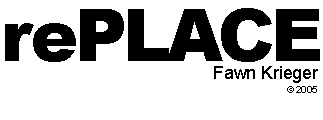
rePLACE
imagines the space of a lake as site of renewal, discovery, and transformation.
Contoured by a static, cushioned and mirrored perimeter, the absence
of a central form anticipates the moment when an individual body reflects
a collective body, and when social movement begins by just one person’s
gesture to look inward and to move outward.
How can we build more room into our personal landscapes?
How can we craft choice and consciousness into the spaces we occupy?
Inspired by the optimistic expansiveness of the utopian architecture
movement of the 1960s, this reversed-moat proposes a handmade structure
as playful stage for social access and support. The audience enters
the implied lake and inadvertently becomes the space of the lake itself,
filling in the contours of its own form. Although there is a defined
point of entry, participants also have the choice of entering the peripheral
cavities, dark crawlspaces that conceal and offer an alternate space
of isolation, removal, and separation.
I spent my time this summer on a lake in the Northeast forests of the
American wilderness. While there, I thought of the men who explored
this metaphorical American notion of PLACE, from the explorers Lewis
& Clark to the characters in The Adventures of Huckleberry
Finn. These are the histories of a nature I was taught to imagine
and occupy as an American girl. This summer I also revisited my grandparents’
former retreat in the woods of Northeastern United States, perched on
a body of water called Fawn Lake. Sharing a name with that lake gave
me a sense of authority and belonging; a nature I could call my own.
By physically re-constructing the lake as a platform, vehicle, and catalyst,
this remembered geography becomes present again, and available to redefine,
reexamine, reestablish, and rePLACE.